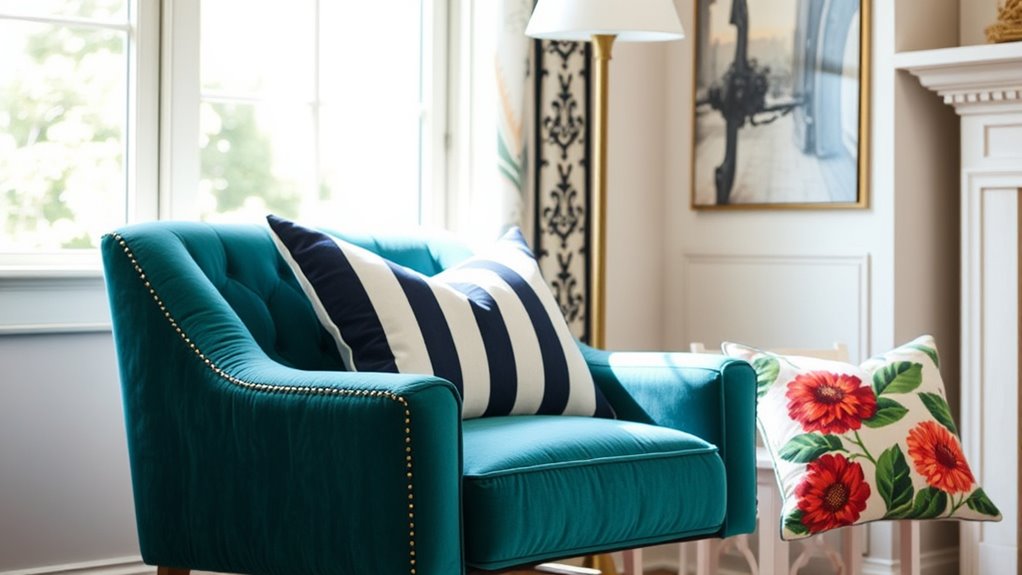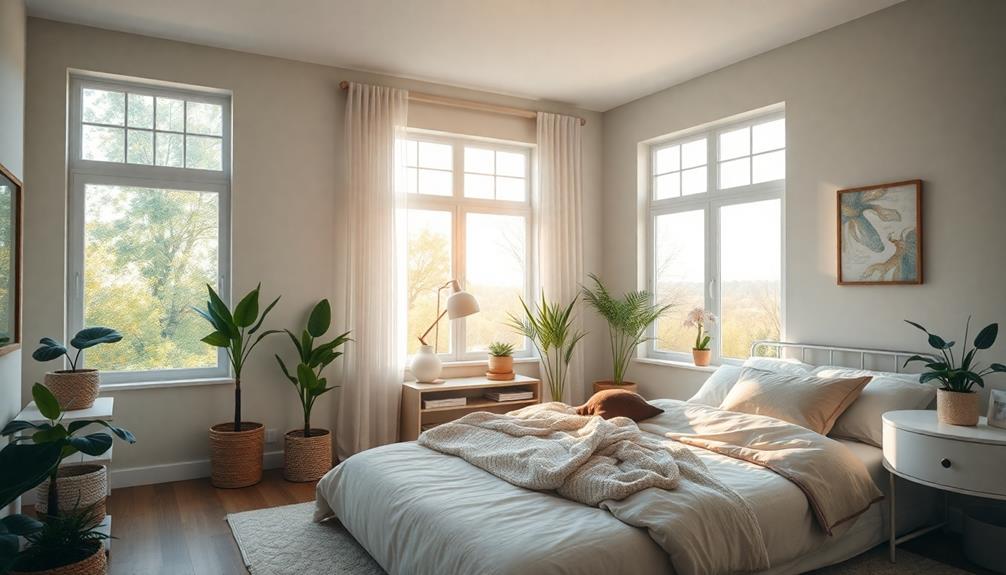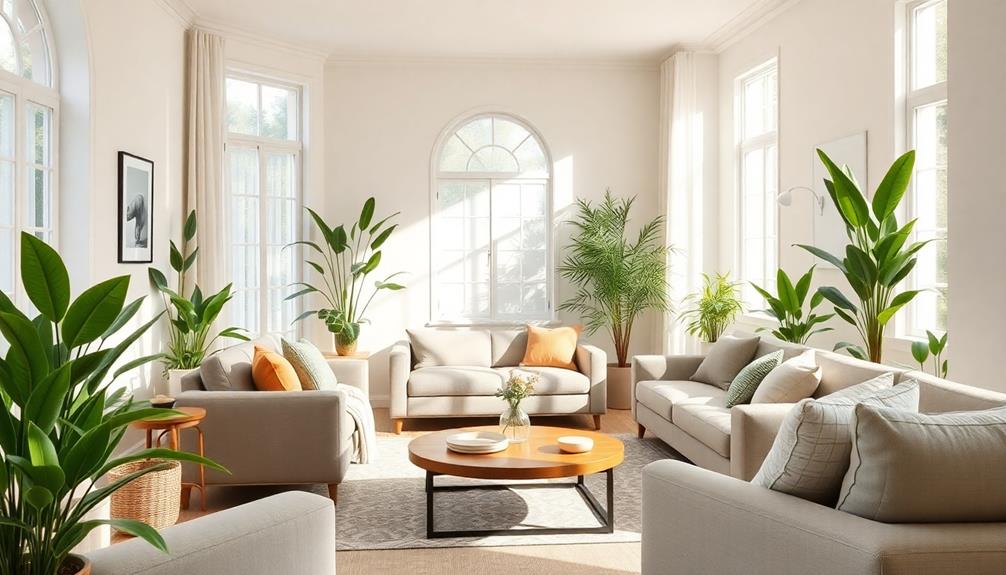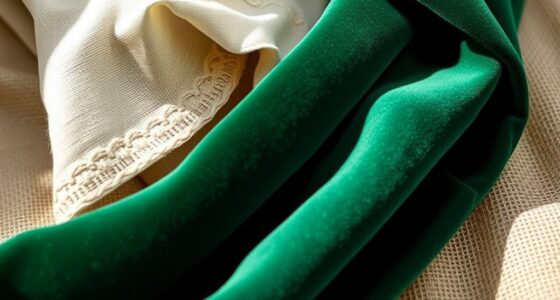To mix patterns without clashing, focus on balancing pattern scale and color harmony. Pair large prints with smaller ones to create contrast, and keep a common or analogous color palette to tie everything together. Keep the rest of your outfit simple, using neutral or solid pieces to prevent visual overload. Pay attention to details like texture and material to add depth. If you keep these tips in mind, you’ll discover more ways to create cohesive, stylish combinations.
Key Takeaways
- Pair patterns of different scales, such as large with small, to create visual contrast and prevent clashing.
- Use a shared or analogous color palette across patterns to ensure harmony and cohesion.
- Balance busy patterns with neutral or solid-colored pieces to keep the outfit visually stable.
- Incorporate textures and rustic materials to add depth without overwhelming the overall look.
- Keep other outfit elements simple and minimal to highlight the patterned pieces effectively.
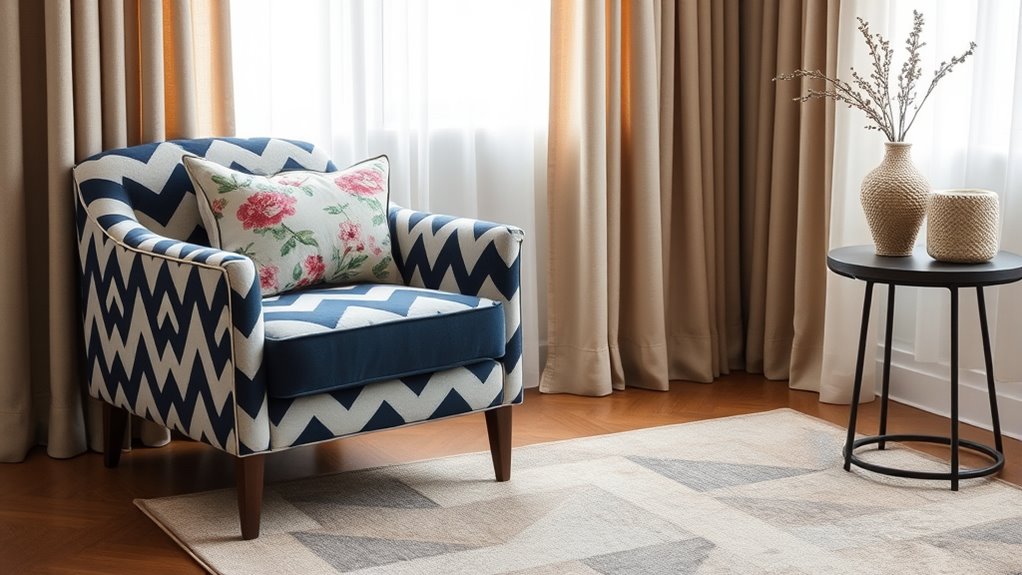
Mixing patterns can instantly elevate your style, but it often feels intimidating to combine different prints without clashing. The key to pulling off a successful pattern mix lies in understanding two essential elements: pattern scale and color harmony. When you get these right, you’ll find it much easier to create visually appealing outfits that look intentional rather than chaotic.
Start by paying attention to pattern scale. Think of scale as the size of the print—tiny, medium, or large. To create balance, pair patterns of varying scales. For example, don’t match a large floral print with a small polka dot; instead, combine a large check with a delicate, tiny stripe. This contrast in scale prevents the patterns from competing with each other and creates a harmonious look. If all your patterns are similarly scaled, your outfit can feel overwhelming or busy. Mixing a large pattern with a smaller one allows each to stand out without overpowering the other, making the overall ensemble more cohesive.
Color harmony is equally vital. You want your patterns to look like they belong together, which is easiest achieved by sticking to a common color palette. You don’t need everything to be the same shade, but complementary or analogous colors work best. For instance, pairing a navy and white striped shirt with a floral skirt that has hints of navy and white creates a seamless visual connection. Avoid clashing colors like bright red with neon green unless you’re intentionally going for a bold statement. Instead, opt for patterns that share at least one color in common or are within the same color family. This creates a sense of unity and makes mixing patterns feel natural rather than jarring.
Stick to a common or analogous color palette for seamless pattern mixing.
Another helpful tip is to keep the rest of your outfit simple. When your patterns are bold or busy, balance them with neutral accessories or solid-colored pieces. This prevents your look from becoming overwhelming and lets your pattern choices shine. Additionally, consider the context—what works casually might not suit a formal setting. Adjust pattern scale and color harmony based on the occasion to keep your style appropriate yet expressive.
A great way to further enhance your pattern mixing skills is by incorporating rustic materials and textures, which add depth and visual interest to your outfits or decor. Ultimately, mastering the art of mixing patterns without clashing comes down to balancing pattern scale and maintaining color harmony. When you pay attention to these details, you’ll find it easier to create outfits that are both stylish and effortless. With practice, you’ll develop an intuitive sense for pairing prints that complement each other, turning what once felt intimidating into a creative expression of your personal style.
Frequently Asked Questions
Can I Mix More Than Two Patterns in One Outfit?
Yes, you can mix more than two patterns in one outfit. Just follow pattern mixing rules like balancing busy prints with solid colors and varying scale for visual harmony. Use style coordination tips such as sticking to a color palette and mixing different pattern types (stripes, florals, polka dots). Trust your instincts, keep it fun, and don’t be afraid to experiment—more patterns can create a bold, stylish look if done thoughtfully.
What Patterns Are Easiest to Combine for Beginners?
Imagine the thrill of mastering pattern matching—it’s easier than you think. For beginners, start with classic stripes and polka dots; their simplicity makes pairing effortless. Use neutral colors to balance bold prints, and keep scales small or similar to avoid overwhelming your look. With these beginner tips, you’ll confidently mix patterns, turning everyday outfits into eye-catching statements. Immerse yourself, experiment, and watch your style come alive!
How Do Scale and Proportion Affect Pattern Mixing?
Scale and proportion play a vital role in pattern mixing by creating scale harmony and maintaining proportion balance. You should choose patterns with varying scales—pair a large, bold print with smaller, subtle ones—to avoid overwhelming your space. When proportions are balanced, the patterns complement each other, ensuring your design feels cohesive and visually appealing. Keep an eye on scale harmony to create a harmonious, well-balanced look effortlessly.
Are There Specific Color Schemes That Clash More Often?
Did you know that contrasting color schemes like red and green or purple and yellow often clash more than harmonious palettes? When you focus on color coordination and contrast balance, you can avoid visual discord. Bright, highly saturated colors tend to clash more easily, so balancing bold hues with neutrals or softer shades helps create a cohesive look. Stick to complementary or analogous color schemes for a safer, stylish pattern mix.
How Can Accessories Help Unify Mixed Patterns?
Accessories help unify mixed patterns by coordinating colors and patterns through accessory coordination, making the overall look cohesive. Use similar hues or complementary shades in your jewelry, scarves, or belts to tie different patterns together. Additionally, choose one pattern to be the pattern accentuation, highlighting it with matching accessories. This balance guarantees your mix looks intentional and stylish, preventing clashing and creating a harmonious, well-put-together outfit.
Conclusion
Now that you know how to mix patterns without clashing, go ahead and experiment confidently. Remember, fashion is about expressing yourself—think of it as your personal renaissance. Don’t be afraid to break the rules and embrace your unique style. With a little patience and a keen eye, you’ll master the art of pattern mixing and turn heads wherever you go. After all, who says you can’t channel a bit of Gatsby’s glamour in today’s modern world?
